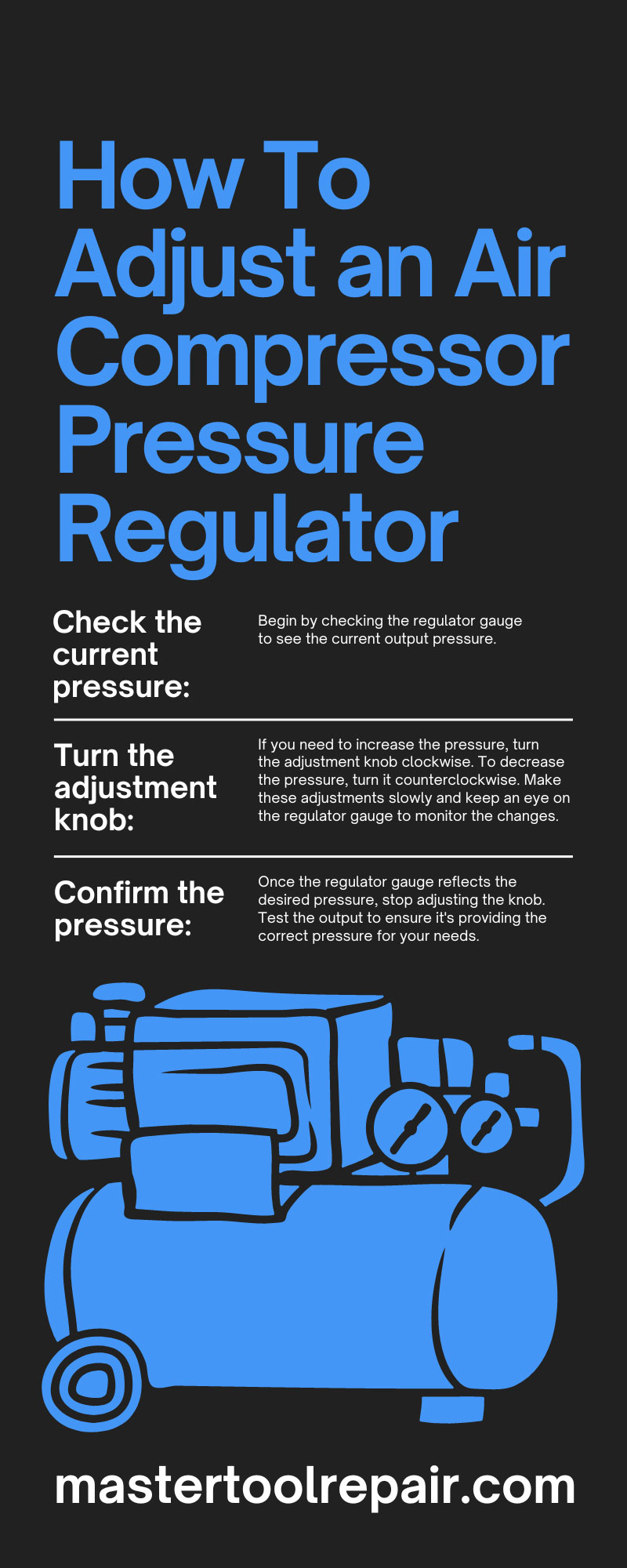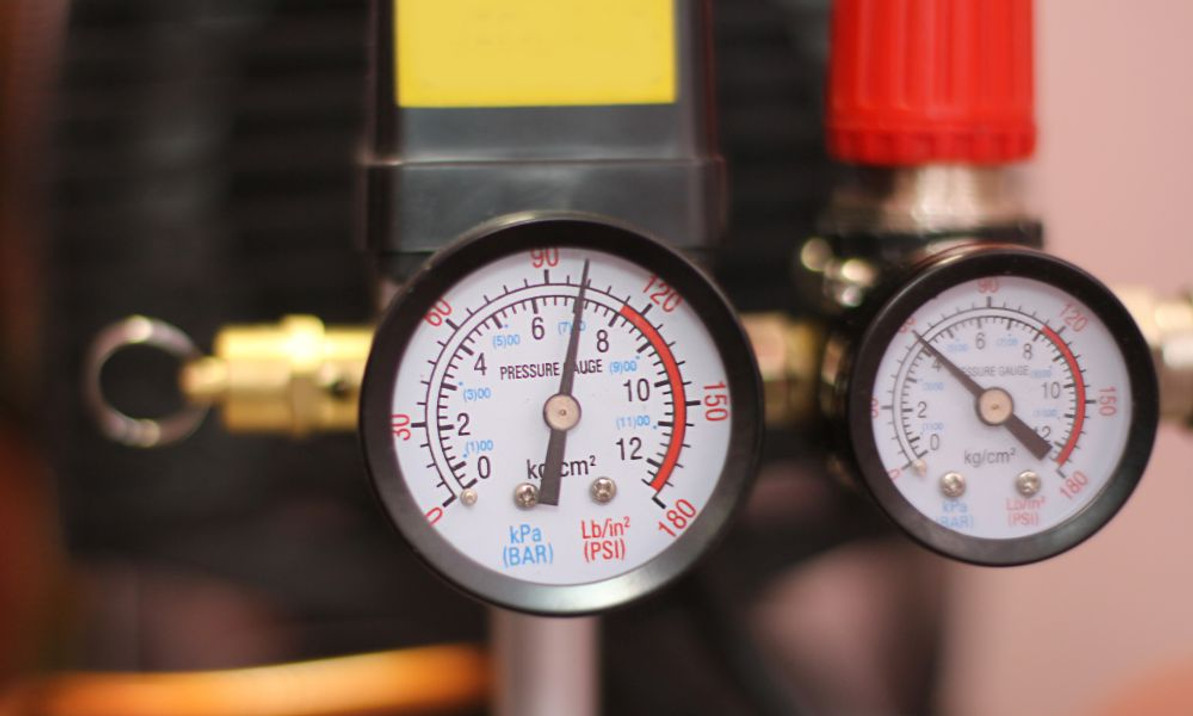How To Adjust an Air Compressor Pressure Regulator
For DIY enthusiasts, small auto shop owners, and small manufacturers, understanding how to adjust an air compressor pressure regulator is an essential skill. The ability to manually control the pressure output can be crucial for a variety of tasks, ranging from inflating tires to powering pneumatic tools. This step-by-step guide on how to adjust an air compressor regulator will walk you through the process, helping you understand the parts of the pressure regulator, how to troubleshoot performance issues, and when and how to replace your air compressor regulator.
What Does the Pressure Regulator Do, Exactly?
The air pressure regulator on an air compressor plays a crucial role in controlling and stabilizing the air pressure that is delivered from the compressor to your tools or equipment. It works by reducing the high pressure from the compressor's tank to a more manageable level suitable for the specific tool being used. The regulator allows you to adjust this output pressure as needed, ensuring optimal performance and safety during operation. Without a properly functioning regulator, the air pressure could be too high.
Understanding Air Compressor Regulator Parts
Before we delve into the adjustment process, let's first identify the key air compressor regulator parts. The pressure regulator typically consists of the following components:
- Regulator gauge: This gauge indicates the amount of pressure (in PSI) that is being supplied to your tools or equipment.
- Tank gauge: This gauge displays the overall pressure within the air compressor tank.
- Adjustment knob: This is the knob that allows you to increase or decrease the pressure output.
The regulator will generally be an obvious part of the machine, but various models and brands locate the pressure regulator in different places relative to the tank. Some pressure regulators are attached to manifolds, which enable multiple hose connections and may have multiple pressure regulators. Manifolds make it possible to run more than one pneumatic tool at a time.
Determining the Correct PSI Setting
If you’re going to adjust your pressure regulator, you need to know what pressure you want to set for the tank and the outlet hose. Determining the correct PSI (pounds per square inch) setting for your air compressor regulator is a crucial step in ensuring the safe and efficient operation of your tools.
The correct PSI varies based on the specific tool you are using. Most pneumatic tools, such as nail guns or air ratchets, will have a recommended PSI range listed in their user manual. It's essential to stay within this range to avoid damaging the tool or compromising safety. If you're inflating something, like a car tire or an inflatable raft, check the item for a recommended PSI. Always start at a lower pressure and gradually increase it until you achieve optimal performance. It's always safer to start low and slowly increase the pressure as needed.
How to Determine the Right CFM for Your Application
Choosing an air compressor with the correct CFM (Cubic Feet per Minute) rating is essential for optimal performance and long-term reliability. Here are the key factors to consider when determining your CFM requirements:
1. Tool Requirements
Every pneumatic tool has a specific CFM requirement. Always check the manufacturer’s specs and make sure your compressor can meet—or exceed—that demand.
2. Continuous vs. Intermittent Use
If you’re using tools continuously (e.g., in a production setting), you’ll need a compressor with a higher CFM output. For intermittent use, a lower CFM may be acceptable since the compressor has time to recover between cycles.
3. Running Multiple Tools
Using more than one tool at the same time? Add up the CFM requirements of each tool to determine your total system demand.
4. Pressure (PSI) Considerations
Don’t forget to factor in pressure. Your compressor must be able to deliver both the required PSI and CFM. Tools requiring higher PSI will often need more airflow as well.
5. Duty Cycle
For prolonged or industrial use, look for a compressor with a 100% duty cycle, which means it’s built to run continuously without overheating.
6. Tank Size
A larger tank can help buffer high air demand by storing compressed air, reducing the need for constant compressor operation—especially helpful for tools with high CFM spikes.
7. Environment & Conditions
Working outdoors, in high-heat areas, or in dusty environments? You may need a compressor with extra filtration or cooling capabilities to maintain efficiency and tool life.
8. Planning for Growth
If you expect to expand your operations or add more tools later, it’s smart to invest in a compressor with higher CFM capacity now to avoid outgrowing your system too quickly.
Adjusting the Pressure Regulator
Now that we've identified what the pressure regulator does, its main components, and the importance of determining the optimal PSI for your tools, let's go through the steps to adjust an air compressor pressure regulator.
- Check the current pressure: Begin by checking the regulator gauge to see the current output pressure.
- Turn the adjustment knob: If you need to increase the pressure, turn the adjustment knob clockwise. To decrease the pressure, turn it counterclockwise. Make these adjustments slowly and keep an eye on the regulator gauge to monitor the changes.
- Confirm the pressure: Once the regulator gauge reflects the desired pressure, stop adjusting the knob. Test the output to ensure it's providing the correct pressure for your needs.
Troubleshooting Pressure Regulator Performance Issues
If you're experiencing difficulties with your air compressor pressure regulator, there are a few common issues to look out for:
- Fluctuating pressure: If the pressure is inconsistent, this might indicate a problem with the air compressor regulator parts, such as a faulty seal or a worn-out spring.
- No pressure change: If turning the adjustment knob doesn't alter the pressure, this could suggest a malfunctioning regulator.
- Over-pressure: If the pressure is too high and cannot be reduced, the regulator might be failing.
In each of these cases, you'll likely need to replace the regulator.
When and How To Replace an Air Compressor Pressure Regulator
If you can’t successfully adjust the pressure regulator on your air compressor, or the regulator can’t maintain the desired pressure, here are the steps to take to replace it:
- Purchase a new regulator: Ensure that the new regulator matches your air compressor's specifications. You can find and order the correct air compressor regulator parts online at Master Tool Repair, and have your machine up and running again quickly when you fix it yourself.
- Disconnect the air compressor: Make sure the air compressor is turned off and unplugged before starting the replacement process.
- Drain the tank: Pull the pressure release valve on your air compressor to make sure the tank is emptied of all compressed air and you’re starting over with a depressurized tank.
- Remove the old regulator: You may need several wrenches of different sizes or a few adjustable wrenches to remove the old regulator. Save all the old parts to compare how they were installed with the new regulator parts you will use to replace them.
- Install the new regulator: Attach the new air compressor regulator according to the manufacturer's instructions, ensuring all connections are secure. The manufacturer may suggest you use Teflon/plumber’s tape on the connections or that you apply an appropriate lubricant to O-rings.
- Test the new regulator: Finally, turn on the air compressor and adjust the new regulator to confirm it is working correctly.
Mastering the art of adjusting your air compressor pressure regulator can save you time and money while ensuring your tools and equipment operate at their optimal levels. With a thorough understanding of the air compressor regulator parts and the steps outlined in this guide, you'll be well-equipped to handle any pressure regulation challenges that come your way.
Master Tool Repair has live support available to help you determine which parts you need, which parts will be compatible with your make and model of air compressor, and how to install a new pressure regulator for safe and efficient operation. Check out our helpful videos and schematics, and give us a call if you need help determining what’s ailing your pressure regulator and how to fix it.

Recent Posts
-
The Sound of Trouble: Diagnosing Strange Noises in Your Air Compressor
Your air compressor is a workhorse, a reliable partner for countless tasks. But what happens when th …Jul 2, 2025 -
Mastering Your Compressor: How to Set the Perfect Pressure for Any Job
One of the most frequent questions we hear at Master Tool Repair is: "What pressure should my air co …Jun 6, 2025 -
What Is an Aftercooler and Why Does Your Air Compressor Need One?
If your air compressor is producing hot, moisture-heavy air, you could be putting your tools and equ …May 22, 2025





